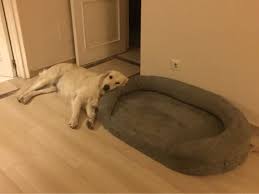|
Whether your looking for a bed for your little one to cuddle up in - one where your dog can spread out - an orthopaedic bed - one that has more padding, or even one that is water resistant - do have a look at what we have to offer - a large, top quality selection. If you are not sure if the bed you want is correct for your dog, please don't hesitate to get in touch with us! www.mcmac.co.za
|
Some reasons why dogs prefer to sleep on the floor instead of their beds
www.alaskasleep.com - this site has a lot of interesting articles on sleep education and problems with sleeping in humans. They also have a free booklet on Sleep Apnea
www.alaskasleep.com - this site has a lot of interesting articles on sleep education and problems with sleeping in humans. They also have a free booklet on Sleep Apnea

You shopped ‘til you dropped, carefully choosing a bed you felt your best friend would appreciate. Instead of sleeping in her bed, though, she’s still sacked out on the floor – right next to her bed!
You’re not alone. Plenty of dog owners wonder why their dogs sleep on the floor instead of in their beds, leading us to investigate the causes. Let’s take a closer look.
Where your dog sleeps says a lot.Dogs spend an average of 12 to 14 hours per day sleeping, and most have a few favorite places to rest depending on the time of day, what’s happening, and where you are. For example, dogs love to demonstrate a close, loving bond by sleeping with us whenever they can – whether that’s on the end of your bed, spooning with you, or cuddled next to you on the couch.
Dogs have a second favorite spot to sleep: Next to our beds! It’s another way of sharing closeness, even when climbing up on the bed or on the couch isn’t allowed, or perhaps isn’t practical; after all, our own ability to sleep well is as important as our pets’ comfort.
If your dog sleeps on the floor under your bed, it’s likely that they’re appreciative of the close relationship they share with you plus they’re expressing the primal urge to relax in a safe den. Just like a heated dog house that provides shelter during time spent outdoors, the space right under your bed provides your dog with a sense of safety. Since you’re close by, your dog may feel that you’re providing protection, or that they’re helping to keep you safe while you’re asleep. It all depends on the relationship you share during your waking hours!
Why do dogs sleep on the floor?
So, why is your dog sleeping on the floor instead of resting in her new, comfy bed?
Unfortunately, it’s impossible to ask your dog outright for the reason why she’s not interested in the bed you so carefully researched, selected, and paid for with your hard-earned cash. The good news is that she’s probably not sleeping on the floor to insult you, and there really isn’t any reason for you to worry about the fact that she’s opting out of her bed for the time being.
Luckily, we’ve come to the conclusion that sometimes, dogs reject their beds for some of the same reasons why people find themselves shopping for new mattresses. Here are five to consider.
1. It’s the wrong temperature - Your dog might be trying to tell you that her new bed is too hot, or perhaps that it’s a little too cold in the spot you’ve selected. During the summertime, that comfy overstuffed bed might hold in excess heat, and the floor might simply feel cooler and more comfortable. During the winter, your dog might need more warmth, and a spot on the floor near a heater or in the sunshine might feel far more cozy than her otherwise comfy bed in the corner.
If you’re looking for a way to keep your dog on her bed, consider moving the bed into her favorite warm spot. This won’t work during the summertime, so consider treating her to an elevated mesh dog bed that allows cool air to circulate all around while she’s sleeping. These tactics aren’t foolproof, but they often work.
2. You’ve chosen the wrong size bed - Your dog longs for security and comfort, and it’s important for her bed to provide her with both. Unfortunately, your dog might have outgrown her bed, so she’s hanging off the edges and isn’t comfortable; or perhaps you’ve chosen a bed that’s just a touch too small. Either way, your dog won’t feel fully supported if her nose or her feet are hanging off the bed and that means she’s probably going to sleep on the floor instead.
Sometimes dogs have the opposite problem: Their beds are too big for them! If you think you’re doing your dog a favor by choosing a bed that’s several sizes too large, think again: While some dogs will happily sleep in the middle of a big bed, most want a bed that’s just right!
Take a look at your dog’s typical sleeping position and measure the area where she sleeps. She might like a large cushion that allows her to fully stretch, or she may prefer a nest-style bed with raised edges that enhance her sense of security.
3. Her bed is uncomfortable -If your dog normally sleeps on her bed and suddenly decides to switch to the floor, take a second look at what’s going on. Are there other signs of discomfort, such as difficulty getting up into a standing position, difficulty sitting, or difficulty jumping? Is your dog getting older? If so, it could be that your dog is looking for relief from ongoing discomfort – and you should talk with your vet about next steps.
Even if your dog is in perfect health, there might be something uncomfortable about her dog bed that’s driving her to sleep on the floor instead. Maybe the bed is worn out and has an uncomfortable flat spot. Maybe the new fabric feels itchy or slippery. It could be anything! Try putting a favorite blanket on top if you suspect that your dog dislikes her bed’s texture: This might just fix the problem.
4. She has always slept on the floor - If you’ve recently adopted your dog, it’s possible that she’s always slept on the floor and never had a bed. She might not know that the comfy new bed is just for her! If this is the case, use a combination of coaxing, treats, and praise to encourage your dog to get accustomed to her bed. She might decide to sleep in it, or she might opt to stick with her old habit of sleeping on the floor.
5. The bed is in the wrong spot - Remember that your dog loves to spend time being as close to you as possible, even when she’s fast asleep. You and she share a special bond, after all! If your dog’s bed is far away from your own bed – even by several feet – she might choose to sleep next to you on the floor instead of resting in her own cozy bed.
Try moving your dog’s bed closer to your own if this is the case. Put the bed in the exact same spot where your dog normally spends the night and encourage her to get on the bed when it’s time.
Don’t feel bad if your dog is choosing to sleep on the floor instead of in her bed. She’s not rejecting your offer of a cozy nest, she’s simply selecting the spot where she feels most comfortable. And, with a few simple modifications, it’s quite likely that you can convince your dog to sleep on her bed – at least part of the time!
Whether you are for or against co-sleeping in the bed or in the bedroom, dogs still need 12 to 14 hours of sleep per day with puppies sleeping 20 hours per day on average. Though it all depends on the breed and size, only 10 percent of a dog’s sleep is in REM unlike humans where 25 percent of sleep is REM.
Hopefully these tips can help you determine the best option for you as a dog owner. However, there is still always a chance your sleep disruptions are truly insomnia or sleep apnea. Our sleep specialists at The Alaska Sleep Clinic can talk for free to get you back on track for a full night’s rest.
You’re not alone. Plenty of dog owners wonder why their dogs sleep on the floor instead of in their beds, leading us to investigate the causes. Let’s take a closer look.
Where your dog sleeps says a lot.Dogs spend an average of 12 to 14 hours per day sleeping, and most have a few favorite places to rest depending on the time of day, what’s happening, and where you are. For example, dogs love to demonstrate a close, loving bond by sleeping with us whenever they can – whether that’s on the end of your bed, spooning with you, or cuddled next to you on the couch.
Dogs have a second favorite spot to sleep: Next to our beds! It’s another way of sharing closeness, even when climbing up on the bed or on the couch isn’t allowed, or perhaps isn’t practical; after all, our own ability to sleep well is as important as our pets’ comfort.
If your dog sleeps on the floor under your bed, it’s likely that they’re appreciative of the close relationship they share with you plus they’re expressing the primal urge to relax in a safe den. Just like a heated dog house that provides shelter during time spent outdoors, the space right under your bed provides your dog with a sense of safety. Since you’re close by, your dog may feel that you’re providing protection, or that they’re helping to keep you safe while you’re asleep. It all depends on the relationship you share during your waking hours!
Why do dogs sleep on the floor?
So, why is your dog sleeping on the floor instead of resting in her new, comfy bed?
Unfortunately, it’s impossible to ask your dog outright for the reason why she’s not interested in the bed you so carefully researched, selected, and paid for with your hard-earned cash. The good news is that she’s probably not sleeping on the floor to insult you, and there really isn’t any reason for you to worry about the fact that she’s opting out of her bed for the time being.
Luckily, we’ve come to the conclusion that sometimes, dogs reject their beds for some of the same reasons why people find themselves shopping for new mattresses. Here are five to consider.
1. It’s the wrong temperature - Your dog might be trying to tell you that her new bed is too hot, or perhaps that it’s a little too cold in the spot you’ve selected. During the summertime, that comfy overstuffed bed might hold in excess heat, and the floor might simply feel cooler and more comfortable. During the winter, your dog might need more warmth, and a spot on the floor near a heater or in the sunshine might feel far more cozy than her otherwise comfy bed in the corner.
If you’re looking for a way to keep your dog on her bed, consider moving the bed into her favorite warm spot. This won’t work during the summertime, so consider treating her to an elevated mesh dog bed that allows cool air to circulate all around while she’s sleeping. These tactics aren’t foolproof, but they often work.
2. You’ve chosen the wrong size bed - Your dog longs for security and comfort, and it’s important for her bed to provide her with both. Unfortunately, your dog might have outgrown her bed, so she’s hanging off the edges and isn’t comfortable; or perhaps you’ve chosen a bed that’s just a touch too small. Either way, your dog won’t feel fully supported if her nose or her feet are hanging off the bed and that means she’s probably going to sleep on the floor instead.
Sometimes dogs have the opposite problem: Their beds are too big for them! If you think you’re doing your dog a favor by choosing a bed that’s several sizes too large, think again: While some dogs will happily sleep in the middle of a big bed, most want a bed that’s just right!
Take a look at your dog’s typical sleeping position and measure the area where she sleeps. She might like a large cushion that allows her to fully stretch, or she may prefer a nest-style bed with raised edges that enhance her sense of security.
3. Her bed is uncomfortable -If your dog normally sleeps on her bed and suddenly decides to switch to the floor, take a second look at what’s going on. Are there other signs of discomfort, such as difficulty getting up into a standing position, difficulty sitting, or difficulty jumping? Is your dog getting older? If so, it could be that your dog is looking for relief from ongoing discomfort – and you should talk with your vet about next steps.
Even if your dog is in perfect health, there might be something uncomfortable about her dog bed that’s driving her to sleep on the floor instead. Maybe the bed is worn out and has an uncomfortable flat spot. Maybe the new fabric feels itchy or slippery. It could be anything! Try putting a favorite blanket on top if you suspect that your dog dislikes her bed’s texture: This might just fix the problem.
4. She has always slept on the floor - If you’ve recently adopted your dog, it’s possible that she’s always slept on the floor and never had a bed. She might not know that the comfy new bed is just for her! If this is the case, use a combination of coaxing, treats, and praise to encourage your dog to get accustomed to her bed. She might decide to sleep in it, or she might opt to stick with her old habit of sleeping on the floor.
5. The bed is in the wrong spot - Remember that your dog loves to spend time being as close to you as possible, even when she’s fast asleep. You and she share a special bond, after all! If your dog’s bed is far away from your own bed – even by several feet – she might choose to sleep next to you on the floor instead of resting in her own cozy bed.
Try moving your dog’s bed closer to your own if this is the case. Put the bed in the exact same spot where your dog normally spends the night and encourage her to get on the bed when it’s time.
Don’t feel bad if your dog is choosing to sleep on the floor instead of in her bed. She’s not rejecting your offer of a cozy nest, she’s simply selecting the spot where she feels most comfortable. And, with a few simple modifications, it’s quite likely that you can convince your dog to sleep on her bed – at least part of the time!
Whether you are for or against co-sleeping in the bed or in the bedroom, dogs still need 12 to 14 hours of sleep per day with puppies sleeping 20 hours per day on average. Though it all depends on the breed and size, only 10 percent of a dog’s sleep is in REM unlike humans where 25 percent of sleep is REM.
Hopefully these tips can help you determine the best option for you as a dog owner. However, there is still always a chance your sleep disruptions are truly insomnia or sleep apnea. Our sleep specialists at The Alaska Sleep Clinic can talk for free to get you back on track for a full night’s rest.





